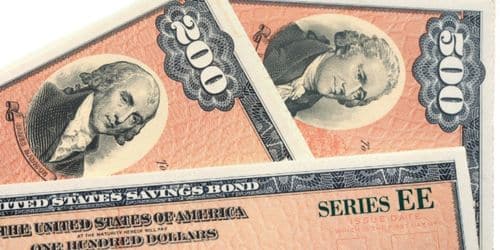One of the most fundamental financial instruments supported by the full faith and credit of the United States government is savings bonds. Investors who want to buy or redeem a US savings bond must be US citizens, legal residents of the US, or US government employees (regardless of citizenship status). We will go over what savings bonds are, how they work, how they generate income over time, how to determine their value, and how to redeem your savings bonds in this article.
How Do Savings Bonds Work
To find out how savings bonds work, you must first realize that the United States government issues them as a form of security to cover its borrowing costs. By purchasing a U.S. savings bond, you are effectively lending money to the government at a fixed interest rate. You can expect the government then to repay the loan in full, which includes both the principal and interest.
Because the United States government backs it, you can regard savings bonds as low-risk investments. In other words, there is very little chance that the US government won’t be able to fulfill its debts related to savings bonds. As a result, the risk to the individual investor is also very low, especially when compared to investments in the stock market. You will receive compound interest when you purchase a savings bond.
Because you can tax-defer U.S. savings bonds, you don’t have to pay taxes as you receive interest from them. Only when you redeem the bond, which is when you cash it in, you will have to pay taxes. Although you can choose to report the interest over the bond’s lifespan, you won’t be responsible for paying taxes until you redeem the bond.
How to Buy Savings Bonds
- Buy Online.
The US Treasury’s electronic savings portfolio website, TreasuryDirect.gov, allows you to buy bonds online. You can select the kind of bond you want to purchase and the denomination after opening an account. The prices for both range from $25 to $10,000 in penny increments. You can track the development of your bonds there, make purchases there, and reinvest there.
- Buy paper
When you file your annual income tax return, you can use the $5,000 in a paper I bond that you will receive from the IRS to make additional purchases.
How to Cash In Your Savings Bonds
Although you can redeem different bonds in various ways, you have to do the majority at a bank or through TreasuryDirect.
You can use your online account to redeem electronic savings bonds, such as those available through the TreasuryDirect website. Contrarily, it takes a little more effort to cash paper bonds. The investor must bring the physical bonds to a bank or other financial organization. To ensure that the institution you have in mind will cash your savings bonds, it is best to give them a call in advance.
If you are a bank customer, you just need to present a legitimate form of identification. Otherwise, the procedure might be slightly more difficult. However, as long as you can prove that you are the rightful owner of the bonds, you won’t have any trouble cashing them in.
It’s crucial to remember that if you wait until your bond matures before cashing it, its value will be at its highest. Because of two things: Your bond will have more time to accumulate compound interest, and you expect some bonds, like Series EE bonds, to double in value when they mature. You will be able to benefit from any built-in price adjustments and earn more interest by delaying the redemption of your bonds.
Understanding U.S. Savings Bonds
A popular kind of government bond is a U.S. savings bond. A governmental body issues them to raise money from the general public to finance its capital projects and other tasks required to manage the economy.
When the government sells bonds, it is essentially borrowing money from the general public that it promises to repay at a future date. The government pays interest to the holders of its bonds as recompense for their capital contributions.
Features of U.S. Savings Bonds
Before going ahead to find out how savings bonds work, you must first understand their features. the following are the features :
#1. Non-Marketable
Since the U.S. savings bond is non-marketable, an investor can only buy it from the U.S. government directly and cannot resell it to any other investors. Since the bond is an agreement between the investor and the United States government, it is effectively nontransferable.
As a result of the bond’s registration with the government, you can replace any lost or damaged savings bond certificate.
#2. Purchase Quantity
A bond buyer is restricted to purchasing no more than $10,000 in face value of US savings bonds per year. You can buy and redeem savings bonds that the United States issues digitally in a government-run site via the TreasuryDirect website. The investor must open a TreasuryDirect account and supply their SSN, email address, and either a checking or savings account.
#3. Interest Payment
U.S. savings bonds are zero-coupon securities that do not accrue interest until either redemption or maturity. For 30 years, the interest will compound every two years and accrue annually. An investment in a bond will stop producing interest payments to the investor after 30 years of holding it.
#4. Effect of Early Redemption
A bond can mature at a variety of times, but it typically takes between 15 and 30 years. Bondholders must wait at least 12 months after the bond’s initial purchase to redeem it; when they do, they will receive the face value of the bond plus interest.
Investors will also be penalized by forfeiting the last three months’ interest if they redeem the bonds within the first five years of purchase. However, you don’t incur any fees in the process of redeeming bonds that you hold for five years.
#5. Tax Consequences
Savings bond interest is not subject to federal, state, or local income taxes. However, only when the bond matures, or after 30 years, when the bond ceases to bear interest, that it incurs federal taxes.
#6. Risk
As a result of the US government’s full faith and credit backing, savings bonds are among the safest forms of investment. In other words, the responsibility for paying you backrests with the government.
#7. Terms
Savings bonds have a 30-year interest-bearing period, but after five years you can cancel them without penalty. If you are familiar with certificates of deposit, you might compare a savings bond to a 30-year CD that waives penalties after the fifth year if you have any experience with them.
Types of U.S. Savings Bonds
Currently, Series EE and Series I bonds—both of which are available for purchase online—are the two varieties of U.S. savings bonds that you can buy.
- Series EE U.S. Savings Bond:
Series E bonds were replaced in 1980 by Series EE savings bonds. You buy and sell these bonds at face value, and upon redemption, they are fully redeemable. These bonds provide a fixed interest rate that is paid upon maturity or redemption.
- Series I U.S. Savings Bond:
1998 saw the launch of the Series I savings bond. Similar to the Series EE bond, the government offers Series I for sale at face value. The interest rate is somewhat erratic because these bonds offer an interest rate that is adjusted for inflation. As inflation continues to rise, the interest rate on savings bonds will also rise. The bonds’ yield is guaranteed never to fall below 0.00% even during deflationary times.
How Long Does It Take for a $100 Savings Bond to Mature?
Series EE bonds currently have a 20-year fixed interest rate guarantee, which covers the bond’s entire life. All Series EE bonds have a 30-year term. The majority of savings bonds cease to accrue interest (or mature) between 20 and 30 years.
The 20-year maturity date for Series EE bonds. After a year, your I bond can be cashed in (redeemed). If you redeem the bond before the stipulated five-year period, you will, however, lose the final three months’ worth of interest.
Are Savings Bonds a Good Investment?
Bonds are still a secure, convenient way to accumulate savings over time. The Treasury promises to not only repay your investment over 20 years but also double it.
Low risk. As a result of the U.S. Treasury’s backing, which has never experienced a debt default, you can be sure that you will receive your interest payments on time and be reimbursed for your principal when the loan is paid off.
Portfolio diversification. You should balance your portfolio by including less risky investments like government bonds as well as riskier, more aggressive investments like stocks, according to the majority of financial advisors.
What Is the Disadvantage of Savings Bonds?
The bond must be redeemed after its usual 30-year term to earn the highest return. You’ll be penalized if you cash the bond before the agreed-upon time. The maximum amount of bonds that can be purchased in any one year is $10,000 for each series (for a total of $20,000), plus an additional $5,000 for the paper I bond. Savings bonds offer a lower yield than a more risky investment.
How Risky Is a Savings Bond?
Savings bonds issued by the United States are backed by the full faith and credit of the United States government, making them one of the safest forms of investment.
Conclusion
Learning how savings bonds work is crucial. Do not forget that investing in them carries little risk. As a result, you have a very low chance of losing money, but you also won’t become rich through the purchase of savings bonds alone. Savings bonds typically make sense as a component of a well-diversified portfolio with a specific investment goal.
Whatever the case, it’s a good idea to familiarize yourself with how savings bonds work and take them into account as a potential investment. The federal government backs U.S. savings bonds, making them risk-free and one of the safest investment options. Despite earning less interest than the stock market, these bonds do provide a less volatile source of income.
Related Articles
- BROKERAGE ACCOUNT: How To Open One in 2023 Step-by-Step Guide
- SAVINGS BONDS FOR KIDS: How to Invest in Savings Bonds for Kids
- COMPOUND INTEREST ACCOUNTS: 15 Best Accounts To Open in 2023 (Updated)
- ARE BONDS A GOOD INVESTMENT Right Now in 2023?
- High Yield Investments: How to Spot High Yield Investments (With Best Options Updated!)






